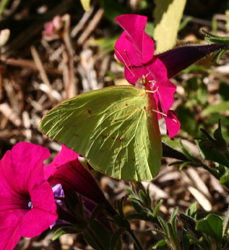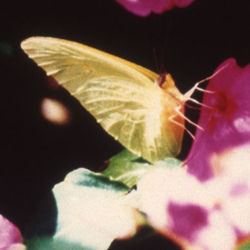Find a Butterfly
Cloudless Sulphur
Phoebis sennae
Named
Linnaeus, 1767

Identification
Wingspan: 2 1/4 2 3/4". The Cloudless Sulphur may be distinguished from other Massachusetts‘ Sulphurs, even on the wing, by its great size. Males are bright, clear yellow, females more golden or less commonly white, with variable black spotting along the wing margins. It never has the black bordered wings characteristic of the much smaller Common Sulphur.
Distribution
Permanent resident from South Carolina south through Gulf states to Central and South America as far as Patagonia. Summer and fall emigrations take the species as far north as Montana and Maine.
Status in Massachusetts
Rare straggler from the South, not reaching the state in most years. Southern coastal New England is typically the species‘ northern limit, with occasional inland records. Said to be "very common" at Wood‘s Hole in the summer of 1880 and "not uncommon" at Nantucket in September 1892 (Farquhar, 1934). Kimball and Jones (1943) noted the species in varying numbers on Nantucket and Martha‘s Vineyard, with 1934 and 1937 years of noted abundance on Martha‘s Vineyard. During the decade 1986-1995, Cloudless Sulphurs ranged as far north as Massachusetts three times, in 1987, 1993, and 1995. The 1993 flight was possibly the largest flight documented for the region, with butterflies seen in fourteen localities over a two-month span, August 8 - October 9. During the period of the Atlas, Cloudless Sulphurs were seen in Massachusetts for one brief timespan, late September/early October 1987: 15-18 individuals in six southeastern coastal towns, one inland in Dedham. It is noteworthy that 1987 was a spectacular year for this species throughout the East, with record numbers observed in many localities. Block Island, Rhode Island hosts the Cloudless Sulphur in small numbers most years. Maximum: 13 on 21 September 1909, Chappaquidick Island (Dukes Co.); 9 12 on 27 September 1987, Westport (Bristol Co.).

Flight Period in Massachusetts
The Cloudless Sulphur is known only as a fall migrant, and may be looked for (but not expected) from August to October. Atlas records, as noted above, are late September to early October.
Larval Food Plants
Various sennas (Caesalpinaceae) comprise the host plants for this species. The Partridge Pea (Cassia fasciculata), a known Cloudless Sulphur host plant, and other sennas of the genus Cassia occur as far north as Massachusetts, though breeding, and resultant larvae, have not been confirmed in the region. There is, however, evidence of breeding as far north as southern New Jersey.
Adult Food sources
Long-tubed flowers are preferred. The species has been reported visiting Cardinal Flower in Rhode Island and in Virginia has utilized several species of wild morning glories.

Habitat
The Cloudless Sulphur is found in open areas and in Massachusetts primarily occurs coastally in dunes, salt marshes, and adjacent scrub growth and gardens.
Life Cycle
EGG: Cream colored when laid, later becoming orange; spindle shaped. OVIPOSITION: Eggs laid singly on host plant leaflets or flower buds. LARVA: Yellow or yellowish green, with ten transverse blackish bands and small, black dotted tubercles. CHRYSALIS: Green or pink, pointed at both ends and flared out in the middle. OVERWINTERING STAGE: Does not overwinter in New England.
None of the immature stages of the Cloudless Sulphur can tolerate cold weather conditions, and thus the species is resident only as far north as South Carolina. In late summer and fall, varying numbers of Cloudless Sulphurs emigrate northward. In New England, adults are observed in various states of wear, many quite ragged from the trials of hundreds of miles of migratory flight. The species is a rapid flyer and is said by Opler and Krizek (1984) to travel "2-4 meters above the ground and...in a direct course" during its fall flights.
Notes
The Cloudless Sulphur is probably as scarce in mainland Massachusetts as the few recent records would indicate. It is unlikely that such a conspicuous butterfly would have gone unnoticed by the many naturalists visiting the coast every fall.
Account Author
Brian Cassie



